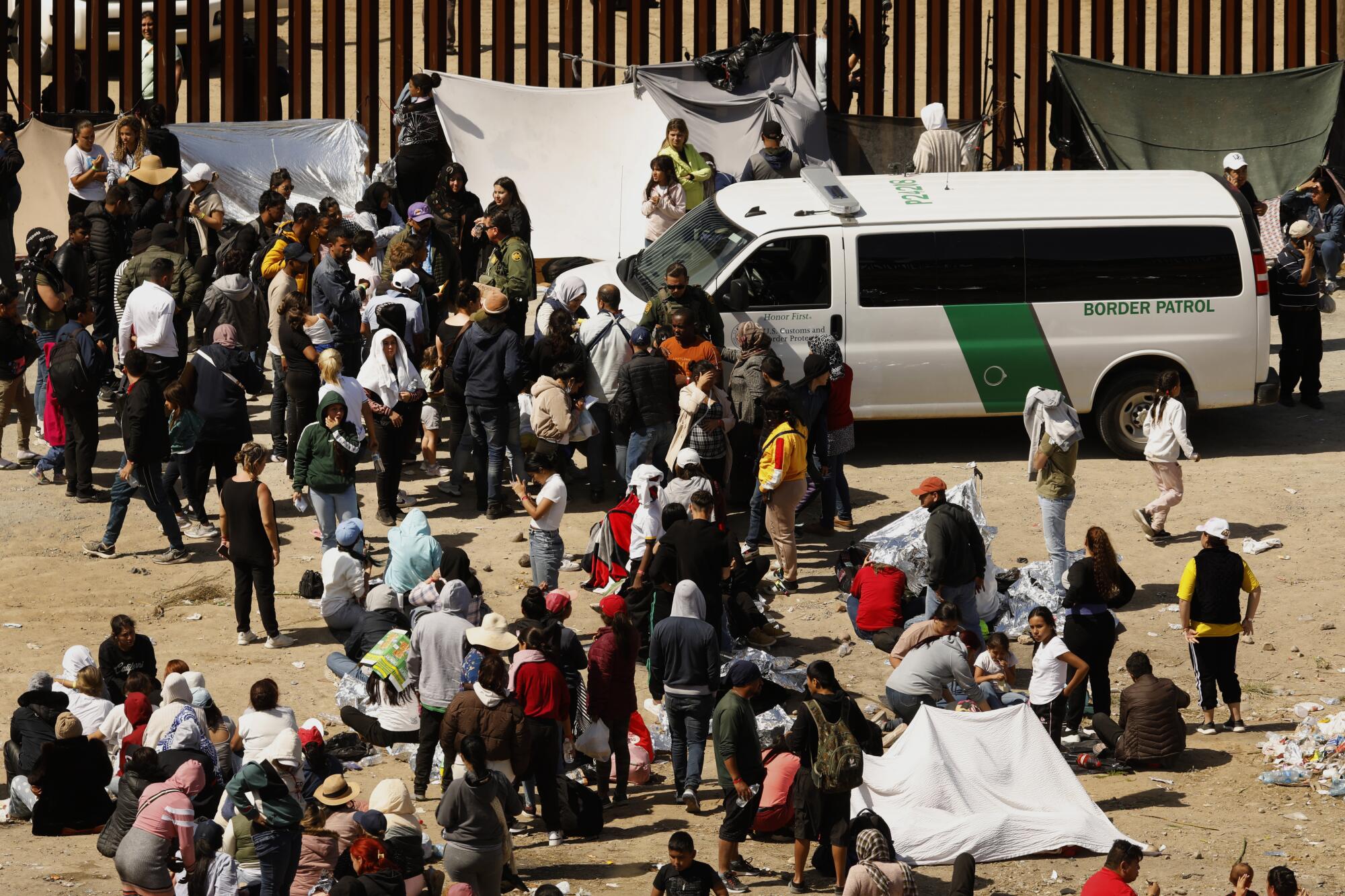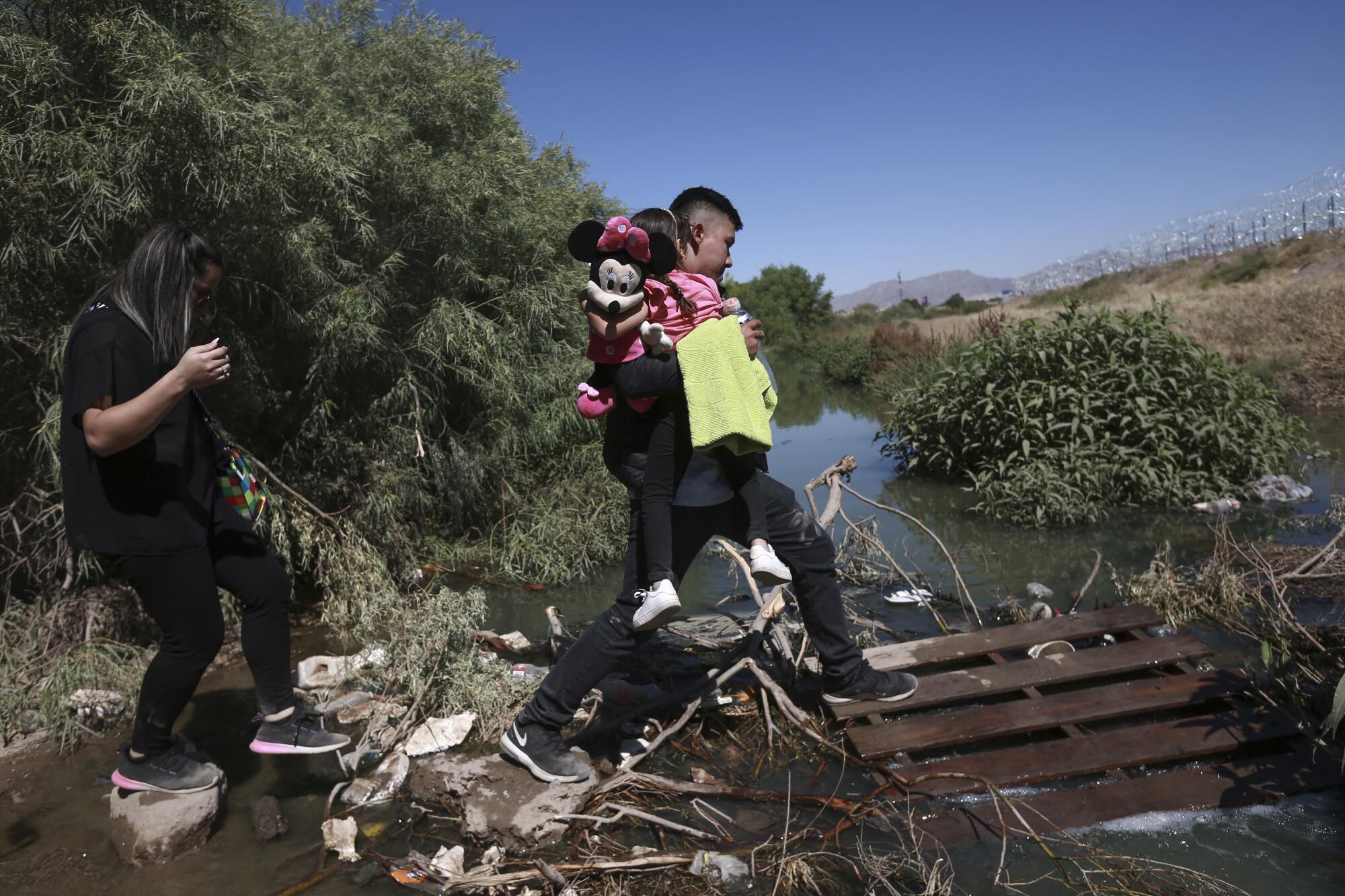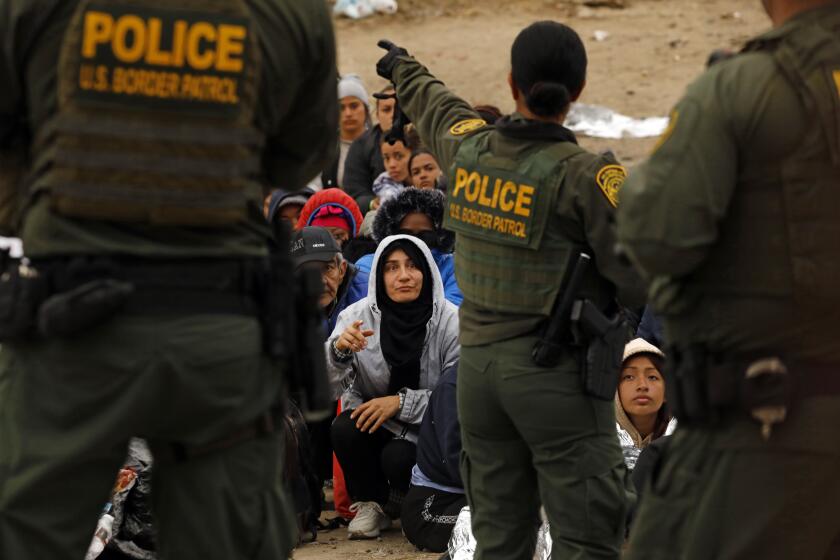
- Share via
MEXICALI, Mexico — The shelter for migrant women and children was running out of space Wednesday when a teary-eyed woman and her 7-year-old son rang the doorbell and sheepishly peeked inside.
The pair had just arrived by bus from the Mexican state of Guerrero, each carrying small, stuffed backpacks, after a gang burned down their house and threatened to kill the woman. Advised by a friend that Mexicali was a good place to cross the border, the 31-year-old woman, who asked to be identified by her initials J.Z. out of fear for her safety, said she had planned to turn herself in to border authorities.
She knew nothing about Title 42, the pandemic-era U.S. border policy set to lift Thursday night. And she had never heard of CBP One, the phone application migrants are required by U.S. authorities to use to make appointments to request asylum.
“It breaks my heart to say I don’t have more space,” said Monika Oropeza, who has run Albergue del Desierto — one of Mexicali’s only free migrant shelters — since 1989. “They come like this daily. And we think more will come with the end of Title 42 because there is all types of bad information, that they can enter [the U.S.] now.”
Across the southern border with Mexico on Wednesday, communities, migrants and border agents braced for the long-anticipated end of Title 42 orders. Most U.S. Customs and Border Protection facilities were already overcapacity. Hundreds of other migrants lined up near ports of entry in Arizona and Texas to see if they would finally be let in.
Border Patrol agents had apprehended more than 10,000 migrants Tuesday, according to internal data obtained by The Times. Customs and Border Protection had more than 28,000 migrants in its custody Tuesday morning, and they were staying on average 65 hours, the data show. By the end of the day, that number had decreased to about 26,000, Border Patrol Chief Raul Ortiz told ABC News.
In Tijuana, migrants wait in an area between two layers of border wall that has become an open-air holding cell for the U.S. Border Patrol.
The U.S. Department of Homeland Security “is struggling to manage the numbers of arriving noncitizens,” a department official told The Times on the condition of anonymity to discuss the matter freely. “Planning for the imminent end of Title 42 while at the same time working to manage a huge surge of migrants places an enormous strain on the workforce and results in a lot of stress and confusion.”
John Sandweg, a former senior DHS official in the Obama administration, theorized that the increase in apprehensions was due to migrants fearing implementation of the upcoming Biden administration policy limiting asylum for those who cross without authorization.
Sandweg said that with such high numbers, it would be “impossible” for CBP not to start releasing thousands of migrants from custody with court dates. The backlog plaguing the immigration court system would require years for cases to be heard, he said.
A new ICE program set to take effect soon will subject migrant families to GPS monitoring and a curfew.
South of the San Ysidro Port of Entry near San Diego, a group of men from Haiti huddled by the colorful Tijuana, Mexico, sign. They had been in Reynosa, a Mexican border city near McAllen, Texas, for a couple of months before they managed to get appointments. They flew to Tijuana a few days ago and had brought few belongings with them.
A mile away, more than 200 people from countries including Colombia, Ecuador, El Salvador and Turkey waited in an area between two layers of border wall that has become an open-air holding cell for Border Patrol. Families said they’d been waiting as many as four days to be processed.
Border Patrol has been holding migrants for extended periods of time between the border walls in the region since at least October. Agents have begun putting wristbands on migrants that indicate which day they were apprehended.

Rep. Robert Garcia (D-Long Beach) said he was disturbed that Border Patrol would hold migrants in such conditions. Garcia sent a letter to Ortiz last week seeking answers about the practice.
“Yes, it is a really large challenge, and yes, we all want a secure border, but it’s also true that these people, most of them, are fleeing horrific conditions and are seeking help,” Garcia told The Times.
San Diego officials have asked the federal government for more resources to aid migrants released in the area. Local hospitals also braced for a possible increase in demand for medical services.
Title 42, the policy used to keep asylum seekers out of the U.S. during the pandemic, expired Thursday night, ushering in a new era for U.S. border control.
Scripps Mercy Hospital Chula Vista Chief Executive Chris Van Gorder said he is concerned that an increase in hospital transports from the border could overwhelm already-packed emergency departments. Migrants falling from the top of the extended border wall have died or sustained gruesome injuries requiring surgeries and long recovery in some San Diego-area hospitals.
In Ciudad Juárez, the busiest illicit crossing in recent months, migrants stranded there for months — many already expelled multiple times back to Mexico under Title 42 — were abandoning shelters, cheap hotels and other sites of stop-gap refuge to fan out along the barren border strip between the Rio Grande and the metal border fence separating the area from El Paso.

Men, women and some children trudged along the river en route to gates in the border fence where U.S. border agents were assembled. Groups of migrants, some numbering 200 or more, gathered nearby in anticipation of Thursday night’s change in border policy that many viewed as a possible opportunity to allow them to finally enter the U.S.
“In Venezuela we have a saying — maybe the third time will be the lucky charm,” said Jonathan Vera, 30.
Like many others, he said he had been stuck in Juárez for months, and on two occasions had crossed and been sent back under Title 42. Last week, he and his wife, Darly, crossed into the U.S. Immigration authorities sent him back but allowed her to remain to pursue an asylum case, he said.
He said he has since lost touch with his wife after he was robbed of his cellphone and other possessions.
“I hope she is all right,” he said of his wife, the mother of the couple’s three girls, ages 7, 8 and 11, who remain in Venezuela. “We had this dream to come here together, start a better life for our family. Maybe now it will happen. Who knows?”
Meanwhile, in Yuma, Ariz., Mayor Douglas Nicholls said the attention on El Paso has drowned out the strain felt by smaller border towns. Migrants are processed in Yuma before they head to other places, including California. The city went from seeing 50 migrants a day early in the pandemic to 600 two weeks ago and 1,000 last weekend, Nicholls said.
“The numbers we’re looking at are far greater than anything we’ve ever had to deal with,” he said, noting that he believes the Biden administration’s planning was inadequate. “Title 42 was always meant to go away. And they’ve known that.”
Andrea Flores, who served in the Biden administration as director for border management at the National Security Council, told The Times that “anyone looking at the situation at the border should be concerned.”
“The policy announcements we have seen this week, like a new home curfew pilot and the promise of regional processing centers that don’t exist yet, do nothing to reduce the massive operational challenge facing border communities in the coming days,” she said. “Every lapse in preparation exacerbates the human costs on both sides of the border.”
Back in sleepy Mexicali, the scene was a world away from the hundreds of migrants waiting to be processed in El Paso. Migrants were housed in shelters instead of tent encampments along the Rio Grande. There were no visible large groups gathered near the Calexico port of entry.
Women at Oropeza’s Albergue del Desierto shelter celebrated a bittersweet Mother’s Day, which falls on May 10 in Mexico. Most had been there for three or four months, unable to secure appointments through the CBP One app, and were desperate for security. They rarely left the shelter out of fear that the violent former partners or gangs they fled would find them.
The women said they had chosen Mexicali because they knew it was a less popular U.S. entry point and they’d have a greater chance of remaining undetected.
Maria Garcia, 49, left Honduras after gangs took over her home and threatened to kill her for working for the government. Her son, a police officer who refused to be a gang informant, fled to Spain.
Garcia said she applied for asylum in Mexico but while the application was pending, the gang found her. Now she hopes to reunite with siblings who live in Long Beach.
“There are so many people like me who are looking for hope and help,” she said. “I just hope the new laws are for the better.”
Times staff writers Hamed Aleaziz reported from Healdsburg, Calif., and Patrick J. McDonnell reported from Ciudad Juárez, Mexico. San Diego Union-Tribune staff writers Kate Morrissey reported from Tijuana and Paul Sisson reported from San Diego. Special correspondent Gabriela Minjares contributed to this report.
More to Read
Get the L.A. Times Politics newsletter
Deeply reported insights into legislation, politics and policy from Sacramento, Washington and beyond. In your inbox twice per week.
You may occasionally receive promotional content from the Los Angeles Times.













